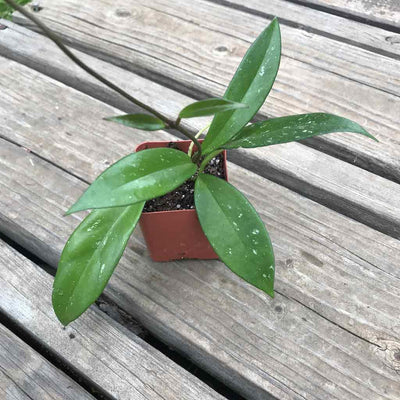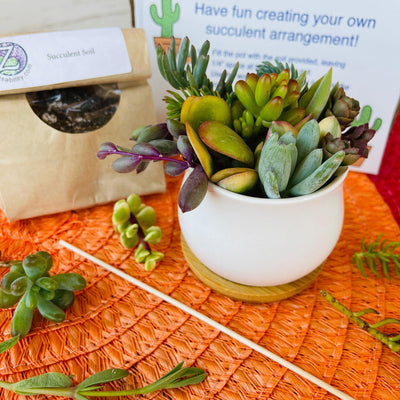How to care for Echeveria succulents
What's an Echeveria?
An Echeveria is one of the easy-care types of succulent plants you often see in arrangements, the ones that look like flowers. This is why these rosette-shaped succulents are often called 'everlasting flowers'.
Echeveria are the main type of succulent that I would consider a 'gateway succulent'. They are so beautiful and colorful and stunning that they are one of the most likely types of succulents to get you hooked - and then draw you into a full-on succulent obsession.
There are probably 1000s of different varieties of Echeveria, so many I could never name them all. There are common types and rare types and hybrids of all those types. Echeveria 'Lola' and Echeveria 'Perle Von Nurnberg' are two classic types of Echeveria you are likely to see in many arrangements and bridal bouquets.
So, if, like me, Echeveria got you started collecting succulents, then you are likely to get totally hooked and start collecting ALL the types of succulents you can find. Which makes it a good idea to learn how to care for Echeveria first, because then you will have a good idea of how to care for most other succulents also.
How to care for Echeveria
One of the first things to note about caring for Echeveria is their rosette shape. Since they are in a rosette shape, and many have cupped, or semi-cupped leaves, they can have a tendency to hold water in the center of the rosette. Or it can puddle at the stem end of the leaves, especially if it's a really tight rosette.
The problem with water pudding in the rosette is usually sunburn. If sun hits the water, it gets magnified and can burn the leaves. This is something to consider when deciding both when and HOW to water your Echeveria.
Wait, there are different ways to water plants?
Yes, and I'll get to that shortly. First, it's important to know that Echeveria defintiely do need to be watered. It's a common misconception that succulents don't need any water, or that they only need a few drops or a spray here and there. If you consider a cactus growing in the desert, it gets hardly any water. But a cactus is made up almost entirely of water, its whole stem and any arms are holding a lot of water, which enables it to survive the dry seasons.
Yes, Echeveria also hold a lot of water in their stem and leaves, but not nearly as much as cactus, so they need to be watered pretty consistently to stay plump and happy.
How to know when to water your Echeveria
There are two ways to tell when it's time to water your Echeveria (and most succulents really). The first is by the top soil. When the top 1/4 inch is dry - completely dry - to the touch, then it's time to water. That's the first way to tell. The second way is by the leaves. If they are starting to look wrinkled and deflated, it is definitely time to water. Any raisin-type texture leaves indicates your plant is ready - and begging - for water.
Also, back to the water puddling, you can water over the top of the rosette, and risk the water puddling as long as it will not be in direct sun or light until the water has evaporated. But there are two ways to water.
So what are the two ways to water your Echeveria?
The two ways to water are:
- from the top
- from the bottom.
We recommend watering Echeveria from the bottom. To do this, simply place your potted Echeveria into a shallow dish of water and leave it there until the top soil is damp. Watering by the bottom-up method ensures that the soil gets statured and your plant gets a good drink. It also prevents water from puddling on the leaves.
Then DON'T water again until the top 1/4" of soil (at least) is completely dry to the touch. This way you will avoid overwatering and keep your Echeveria happy.
What type of soil is best for Echeveria?
This brings us to the type of soil you should use for Echeveria. If you use potting soil, it is likely too dense and will hold too much water. This means even if you wait until the top 1/4 inch is dry to the touch, the rest of the soil could still be holding a lot of water, and you'll end up overwatering your succulent. Which will likely kill it.
Instead, you want to make sure that you use very well-draining soil for your Echeveria. If you only have access to indoor or houseplant potting soil, then it's time to do a little mixing magic of your own. You can make potting soil drain better by adding perlite or pumice. Both of these additives are available at most garden and big box home stores. Both of these additives will help the soil drain quicker and give the roots some breathing room.
How to mix your own succulent soil
We recommend you add 1 part perlite or pumice to 3 parts potting soil. It is better to have your soil be too well-draining than not well-draining enough. Overwatering is the number one killer of homegrown succulents.
Best succulent soil right out-of-the-bag
For a great succulent mix right out of the bag, we recommend our hand-mixed soil or Kellog's Citrus, Cactus & Palm soil. Either are excellent and very well-draining, making it easy to keep your succulents happy.
Sufficient light is needed to keep Echeveria happy and compact
Why would you want to keep your Echeveria compact? You want the rosette to stay compact and 'tight', because that means it is not stretching and looking for more light. You can tell if it's stretching for light by the amount of space between each layer of leaves. You want there to be hardly any space between the leaf layers. This means that your plant is getting plenty of light.
But this does not mean Echeveria want full sun (4-6 hours of direct sunlight). In fact, most Echeveria just want partial sun (2-3 hours of direct sunlight). They are likely to get sunburnt or too stressed if they get too much sun or direct light.
If you are planting them outdoors, you want to choose a spot that will get partial shade, mid-day is preferred. Especially in the summer. If you have them indoors, they will need to be kept close to a window or close to grow lights.
If you do keep them indoors, make sure they get adequate air circulation. But don't place them too close to a fan, heat source, or air conditioner. All of those can sap too much moisture from the plant too quickly.
And that's it, even though we covered a lot, caring for Echeveria is pretty simple. Because...
Echeveria ARE easy-care plants
- Use a well-draining soil and a pot with at least one drainage hole.
- Only water when the top 1/4" of soil is dry to the touch.
- Provide adequate light and air circulation, partial sun is ideal.
If you ever have any questions about your succulents, just reach out: hello@zensability.com
We are always happy to help!
Ready to adopt an Echeveria? Shop the selection of Echeveria succulents for sale on zensability.com.










Leave a comment